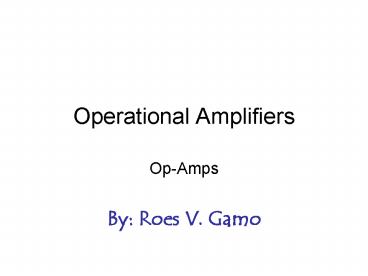Operational Amplifiers - PowerPoint PPT Presentation
1 / 9
Title:
Operational Amplifiers
Description:
An operational amplifier (op-amp) is a high-gain direct-coupled multistage ... Av = 1 Zi Zo = 0. The voltage follower is a impedance matching circuit. ... – PowerPoint PPT presentation
Number of Views:98
Avg rating:3.0/5.0
Title: Operational Amplifiers
1
Operational Amplifiers
- Op-Amps
- By Roes V. Gamo
2
- An operational amplifier (op-amp) is a
high-gain direct-coupled multistage amplifier
with the capability of amplifying signals ranging
from DC (0 Hz) to several megahertz. - Op-amps have five basic terminals one for the
positive supply, one for the negative supply, two
for the input signals, and one for the output
signal. - The positive and negative power supplies
connected to the op-amp allow the output voltage
to swing positive or negative (with respect to
ground).
3
Any voltage applied to the noninverting input
appears at the output with the same polarity.
It should be noted that the () and (-) symbols
at the op-amp input terminals have nothing to do
with polarities of voltages at the inputs. The
voltage at either input can be positive or
negative.
4
- An ideal op-amp has infinite input impedance,
zero output impedance, and infinite voltage gain.
- When an amplifier has a high input impedance, it
will draw a low value of current from the signal
source. - The low output impedance allows the amplifier to
provide a constant output voltage, independent of
the current drawn from the source.
5
- An ideal op-amp will produce an output voltage of
0 V when the voltage applied between the two
input terminals is zero. - In a practical op-amp the output is never exactly
0 V, although it is close enough for most
applications. - If the output voltage is required to be exactly
zero when both inputs are zero, it is possible to
apply a small DC bias voltage to correct, or
offset, the discrepancy. - This compensating voltage is called the input
offset voltage.
6
- Op-amps often use feedback to establish a
specific voltage gain. - Feedback is defined as taking a portion of the
output signal and feeding it back to the input. - When an op-amp has its output connected to one of
its inputs it is referred to as a closed-loop
configuration. - An op-amp with no feedback is called an
open-loop circuit. - The open-loop voltage gain of an op-amp is
typically 200,000. - The two basic types of feedback in electronic
circuits are negative feedback and positive
feedback. - When the output voltage is in phase with the
input voltage, the feedback signal will add to
the input. This is called positive feedback. - When the output signal is out of phase with the
input, the feedback signal will subtract from the
input. This is known as negative feedback. - Because op-amps have very high open-loop gain,
they are generally designed to operate in
circuits that develop negative feedback.
7
INVERTING AMPLIFIER
- When an op-amp is used as an inverting amplifier,
the input signal is fed into the inverting input
and the noninverting input is grounded. - Resistor Rf provides a closed loop between the
output and the input, and the output voltage is
180 out of phase with the input. - Because the voltage drop across Rf is the
opposite polarity to the applied voltage, it is
said to have negative feedback. - The voltage between the () and (-) inputs is
essentially equal to zero volts. - Because the () terminal is grounded, the (-)
input terminal is at 0 V and is referred to as a
virtual ground. - It is called virtual ground because the terminal
is at ground potential, but is not physically
connected to the system or chassis ground.
8
NONINVERTING AMPLIFIERS
- When the op-amp is connected so that there is no
phase displacement between the input and output
signals, it is called a noninverting amplifier.
- In this circuit, the input signal is applied at
the noninverting input (). Resistors Rf and R1
basically form a voltage divider at the inverting
input (-). - The circuit uses negative feedback.
9
Voltage Follower
Av 1 Zi 8 Zo 0 The voltage follower
is a impedance matching circuit. The voltage
follower is called a buffer It is used to connect
a high-impedance voltage source to a very low load































